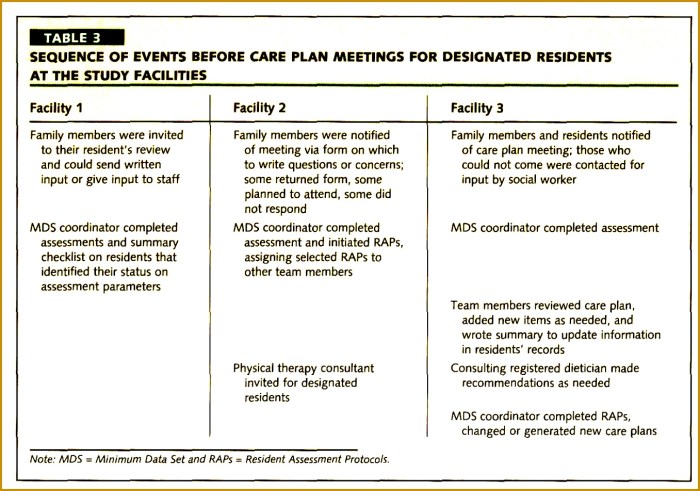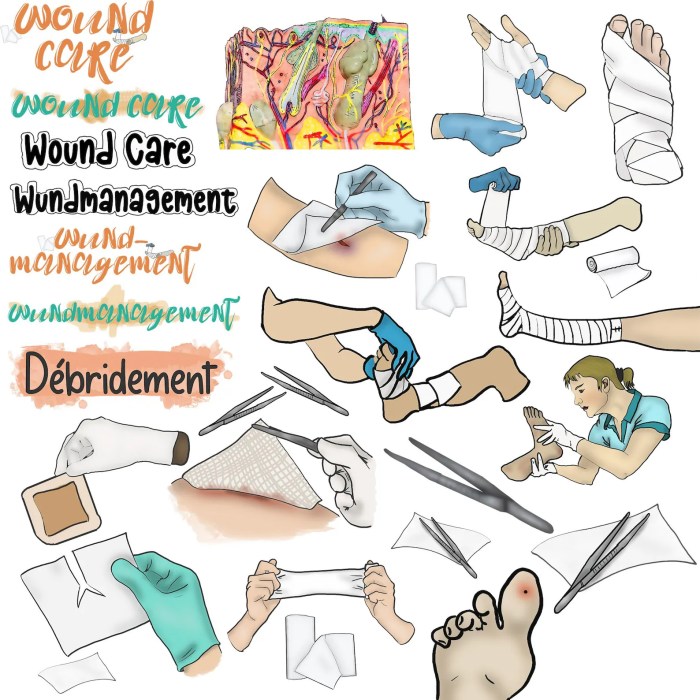Embark on a comprehensive journey into nurse teaching on wound care, where we delve into the intricacies of wound healing, assessment, management, and patient education. This guide empowers nurses with the knowledge and skills to effectively care for patients with wounds, promoting optimal healing outcomes and enhancing their overall well-being.
From understanding the principles of wound healing to mastering wound assessment techniques, this guide covers every aspect of wound care. We explore the different types of wounds, their signs and symptoms, and the importance of proper wound cleansing and dressing.
We also discuss the role of nutrition, hydration, and antibiotics in wound management, ensuring a holistic approach to patient care.
Understanding Wound Care

Wound care is the process of treating and managing wounds to promote healing and prevent complications. Understanding the principles of wound healing, the different types of wounds, and the signs and symptoms of infection is essential for effective wound care.
Principles of Wound Healing
Wound healing is a complex process involving several stages:
- Inflammation:The initial response to injury, characterized by redness, swelling, heat, and pain.
- Debridement:The removal of dead or damaged tissue from the wound.
- Proliferation:The formation of new tissue, including new blood vessels and cells.
- Remodeling:The reorganization and strengthening of the new tissue.
Types of Wounds
Wounds are classified based on their cause, location, and severity:
- Acute wounds:Fresh wounds caused by trauma or surgery.
- Chronic wounds:Wounds that fail to heal within a reasonable time frame, often due to underlying medical conditions.
- Open wounds:Wounds where the skin is broken and exposed to the environment.
- Closed wounds:Wounds where the skin is intact but underlying tissue is damaged.
Signs and Symptoms of Infection
It’s crucial to recognize the signs of infection to prevent complications:
- Increased pain or tenderness
- Swelling, redness, or warmth
- Pus or drainage
- Fever or chills
- Delayed healing
Wound Assessment

Wound assessment is a crucial step in wound care as it provides valuable information to guide treatment and monitor progress. It involves a comprehensive evaluation of the wound to determine its characteristics, extent, and healing status.
Measuring and Documenting Wound Size
Accurate measurement and documentation of wound size are essential for tracking healing progress and evaluating treatment effectiveness. The wound should be measured in centimeters (cm) or millimeters (mm) using a ruler or measuring tape.
Nurses play a crucial role in educating patients on proper wound care. They provide clear instructions on wound cleansing, dressing changes, and infection prevention. If you’re looking for additional resources on essay writing, check out ap lang 2021 sample essays for insights and guidance.
By following these teachings, patients can actively participate in their recovery and prevent complications.
Record the length, width, and depth of the wound, as well as any undermining or tunneling. If the wound is irregular in shape, divide it into smaller sections and measure each section separately.
Assessing Wound Pain
Pain assessment is an important aspect of wound care as it affects patient comfort and overall well-being. Wound pain can be caused by various factors, including inflammation, tissue damage, and nerve irritation.
Use a pain scale, such as the Visual Analog Scale (VAS) or the Numeric Rating Scale (NRS), to assess the patient’s pain intensity. Ask the patient to rate their pain on a scale of 0 to 10, where 0 indicates no pain and 10 indicates the worst pain imaginable.
Wound Cleansing and Dressing

Proper wound care involves keeping the wound clean and protected to promote healing and prevent infection. This includes regular cleansing and dressing changes.
Methods of Wound Cleansing
Wound cleansing aims to remove debris, bacteria, and other contaminants from the wound. Common methods include:
- Saline irrigation:Using a sterile saline solution to gently flush the wound.
- Antiseptic solution:Applying a diluted antiseptic solution to kill bacteria.
- Mechanical debridement:Using gauze or a soft brush to gently remove dead tissue.
Purpose of Wound Dressings
Wound dressings serve several purposes:
- Protect the wound:Dressings shield the wound from external contaminants and trauma.
- Absorb exudate:Dressings absorb fluids from the wound, keeping it dry and clean.
- Promote healing:Some dressings contain antimicrobial or healing agents that aid in tissue regeneration.
Applying and Changing Dressings
Dressing changes are essential for maintaining a clean and protected wound. Here are the steps:
- Gather materials:Clean gloves, sterile dressing, saline solution, and antiseptic (if needed).
- Clean the wound:Gently cleanse the wound with saline or antiseptic solution.
- Remove old dressing:Carefully remove the old dressing without damaging the wound.
- Apply new dressing:Place the new dressing over the wound, ensuring it covers the entire area.
- Secure the dressing:Use tape or other means to secure the dressing in place.
Wound Management

Wound management involves strategies to promote healing and prevent complications. It encompasses wound assessment, cleansing, dressing, and addressing underlying factors that may impair healing.
Types of Wound Management Strategies, Nurse teaching on wound care
- Moist wound healing:Maintains a moist wound environment using dressings that absorb exudate but keep the wound bed moist.
- Dry wound healing:Allows the wound to dry out and form a scab, which can be less effective in promoting healing.
- Negative pressure wound therapy:Uses a vacuum to remove exudate and promote wound closure.
- Hyperbaric oxygen therapy:Delivers pure oxygen to the wound site to stimulate healing.
Importance of Nutrition and Hydration
Adequate nutrition and hydration are crucial for wound healing. Protein intake supports collagen production, while vitamins and minerals (e.g., vitamin C, zinc) promote tissue repair. Dehydration can impair blood flow and oxygen delivery to the wound, hindering healing.
Role of Antibiotics in Wound Care
Antibiotics are prescribed when there is a risk of infection or an active infection in the wound. They target bacteria that can delay healing and cause complications. However, overuse of antibiotics can lead to antibiotic resistance, so they should be used judiciously and as directed by a healthcare professional.
Patient Education
Patient education is a crucial aspect of wound care, as it empowers patients to take an active role in their recovery and prevent complications. By understanding the principles of wound care, patients can make informed decisions, adhere to treatment plans, and monitor their progress.
Tips for Patient Education
- Use simple and clear language that patients can easily understand.
- Provide written materials, such as handouts or brochures, to reinforce verbal instructions.
- Use visual aids, such as diagrams or pictures, to illustrate key concepts.
- Encourage patients to ask questions and express any concerns they may have.
- Tailor the education to the patient’s individual needs and learning style.
Role of Support Groups
Support groups can play a valuable role in wound care by providing patients with a sense of community and shared experiences. In these groups, patients can connect with others who are facing similar challenges, share tips and strategies, and receive emotional support.
Wound Care Resources: Nurse Teaching On Wound Care

Seeking professional help for wound care is crucial to ensure proper healing and prevent complications. Several resources are available to assist you in finding the right care.
Finding a Wound Care Specialist
To find a wound care specialist, consider the following:
-
-*Referrals
Ask your doctor or healthcare provider for recommendations.
-*Online directories
Search for wound care specialists in your area using online directories like the American Academy of Wound Management (AAWM) or the Wound Ostomy and Continence Nurses Society (WOCN).
-*Support groups
Join support groups for wound care patients to connect with others and gather information about specialists.
Key Questions Answered
What are the principles of wound healing?
Wound healing involves four distinct phases: hemostasis, inflammation, proliferation, and remodeling. Each phase plays a crucial role in restoring the integrity and function of the damaged tissue.
How do I assess a wound?
Wound assessment involves a systematic examination of the wound to determine its size, depth, type, and presence of infection. It includes measuring the wound dimensions, evaluating the surrounding skin, and assessing the patient’s pain level.
What are the different types of wound dressings?
Wound dressings serve various purposes, including protecting the wound from infection, absorbing exudate, and promoting a moist wound environment. Common types of dressings include gauze, hydrocolloids, foams, and alginates.
How do I prevent wound infection?
Preventing wound infection is crucial to ensure optimal healing. Nurses play a vital role in maintaining a clean wound environment, promoting proper wound care techniques, and administering antibiotics when necessary.
What is the role of patient education in wound care?
Patient education empowers patients to actively participate in their wound care. Nurses provide instructions on wound care techniques, signs and symptoms of infection, and the importance of adhering to treatment plans, promoting self-management and improving healing outcomes.